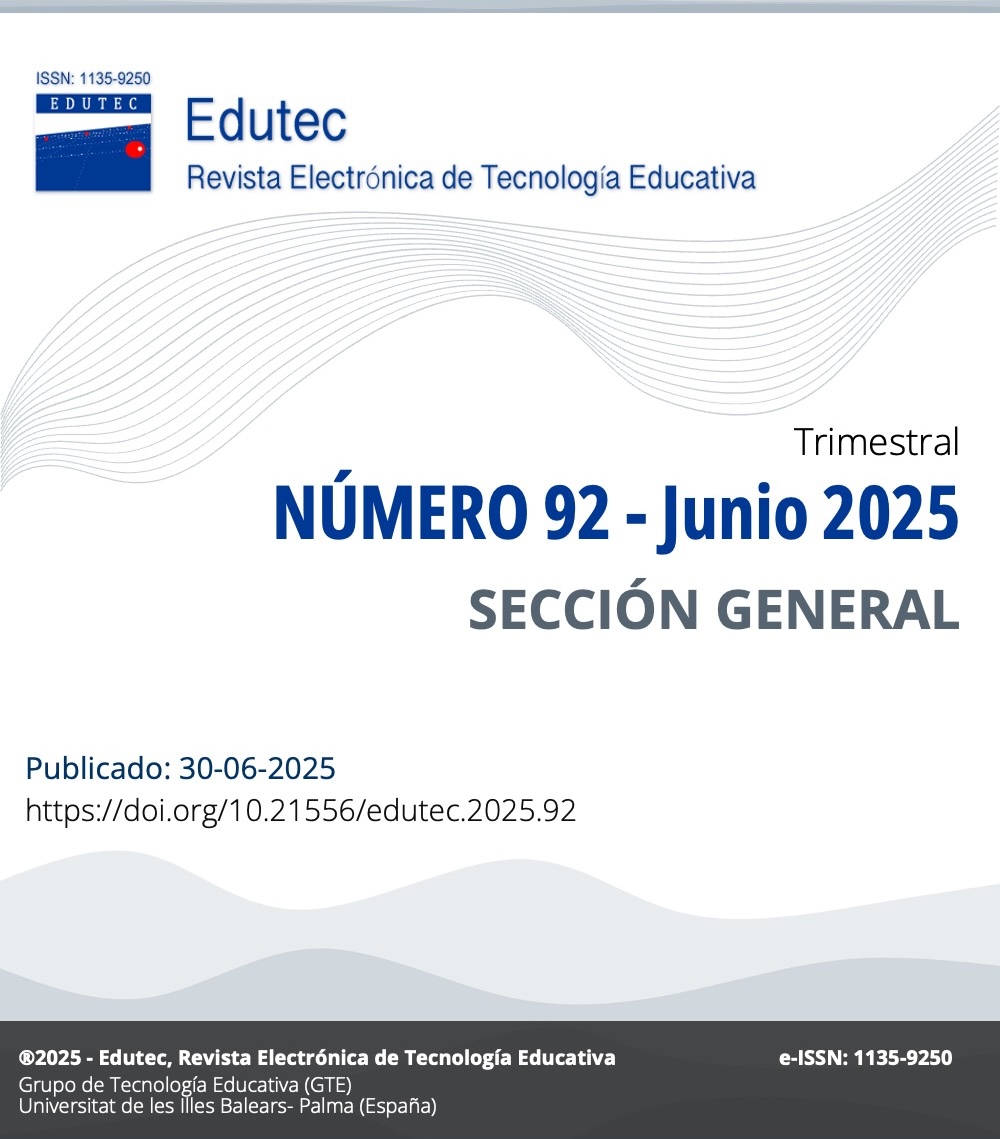Evaluation of the impact of the elimination of graphing calculators in university entrance exams for Mathematics II in Castilla-La Mancha
DOI:
https://doi.org/10.21556/edutec.2025.92.3831Keywords:
graphing calculator, academic performance, Mathematics II, university entrance examsAbstract
The present study aims to analyze the impact of the elimination of graphing calculators in the university entrance exams for Mathematics II in Castilla-La Mancha during the academic years 2021-22, 2022-23, and 2023-24. Using a quantitative methodology and analyzing 13,451 data points, the study examines the evolution of student performance across the campuses of Albacete, Ciudad Real, Cuenca, and Toledo. The results indicate a progressive increase in average grades, accompanied by greater homogeneity in scores. Contrary to expectations, the removal of graphing calculators in 2023-24 did not negatively affect academic performance. On the contrary, students appear to have improved their analytical skills and conceptual understanding, adapting to the new assessment conditions. In other words, this research demonstrates that changes in evaluation conditions can influence learning strategies without necessarily harming student performance. Finally, the findings highlight the importance of reviewing educational policies and their alignment with the development of mathematical competencies, promoting methodologies that enhance conceptual understanding beyond the use of technological tools.
Downloads
References
Álvarez Gómez, M., González Romero, V. M., Morfin Otero, M. y Cabral Araiza, J. (2005). Aprendizaje en línea. Puerto Vallarta: Centro Universitario de la Costa, Universidad de Guadalajara.
Álvarez Gómez, M., González Romero, V. M., Morfin Otero, M., & Cabral Araiza, J. (2005). Aprendizaje en línea. Puerto Vallarta: Centro Universitario de la Costa, Universidad de Guadalajara.
Berry, J. y Francis, B. (2000). Descubrir las matemáticas avanzadas a través de actividades con calculadoras. En P. Gómez y B. Waitts (Eds.), Papel de las calculadoras en el salón de clase. pp.3-14. Bogotá: una empresa docente.
Clements, D. H. (2000). From exercises and tasks to problems and projects. The Journal of Mathematical Behavior, 19(1), 9-47. https://doi.org/10.1016/s0732-3123(00)00036-5 DOI: https://doi.org/10.1016/S0732-3123(00)00036-5
Cohen, L., Manion, L., y Morrison, K. (2017). Research Methods in Education. Routledge. DOI: https://doi.org/10.4324/9781315456539
Creswell, J. W., y Creswell, J. D. (2017). Research design: Qualitative, Quantitative, and Mixed Methods Approaches. SAGE Publications.
Delors, J. (1996). La Educación encierra un tesoro, informe a la UNESCO de la Comisión Internacional sobre la Educación para el Siglo XXI (compendio).
Dunham, P. H., & Dick, T. P. (1994). Connecting research to teaching: research on graphing calculators. The Mathematics Teacher, 87(6), 440-445. https://doi.org/10.5951/MT.87.6.0440 DOI: https://doi.org/10.5951/MT.87.6.0440
Gil, J. M. S. (2006). Tecnologías para transformar la educación. Ediciones Akal.
Hernández, R., Fernández, C. y Baptista, P. (2014). Metodología de la investigación (Vol. 6, pp. 102-256). México: McGraw-Hill.
Hurtado, J. L. J. y Benavides, P. M. E. (2024). El impacto de las tic en el ciclo de aprendizaje. Polo del Conocimiento: Revista científico-profesional, 9(1), 93-116. https://doi.org/10.23857/pc.v9i1.6370 DOI: https://doi.org/10.23857/pc.v9i1.6370
Laborde, C. (2002). Integration of Technology in the Design of Geometry Tasks with Cabri-Geometry. International Journal of Computers for Mathematical Learning, 6, 283–317. https://doi.org/10.1023/A:1013309728825 DOI: https://doi.org/10.1023/A:1013309728825
Ministerio de Educación, Formación Profesional y Deportes (2023). Estadística de la Sociedad de la Información y la Comunicación en los centros educativos no universitarios. https://www.educacionfpydeportes.gob.es/prensa/actualidad/2024/05/20240527-sociedadinformacion.html#:~:text=El%2081%25%20de%20los%20centros%20educativos%20no%20universitarios%20en%20Espa%C3%B1a,la%20Sociedad%20de%20la%20Informaci%C3%B3n
NCTM (2000). Principles and Standards for School Mathematics. Reston, VA: The National Council of Teachers of Mathematics.
Pallant, J. (2020). SPSS Survival Manual. Routledge eBooks. https://doi.org/10.4324/9781003117452 DOI: https://doi.org/10.4324/9781003117452
Real Decreto 534/2024, de 11 de junio, por el que se regulan los requisitos de acceso a las enseñanzas universitarias oficiales de Grado, las características básicas de la prueba de acceso y la normativa básica de los procedimientos de admisión.
Santaló, L. (1992). Temas nuevos en la enseñanza de la matemática en el nivel secundario. Elementos de Matemática, 7(26), 11-28.
UNESCO. (2015). Educación 2030 Declaración de Incheon y Marco de Acción hacia una educación inclusiva y equitativa de calidad y un aprendizaje a lo largo de la vida para todos. Incheon: UNESCO.
Published
How to Cite
Issue
Section
License
Copyright (c) 2025 Edutec, Revista Electrónica de Tecnología Educativa

This work is licensed under a Creative Commons Attribution 4.0 International License.
By submitting the paper, the authors assign the publication rights to the journal Edutec. For its part, Edutec authorises its distribution as long as its content is not altered and its origin is indicated. At the end of each article published in Edutec, the citation procedure is indicated.
The management and editorial board of Edutec Revista Electrónica de Tecnología Educativa do not accept any responsibility for the statements and ideas expressed by the authors in their work.
Translated with www.DeepL.com/Translator (free version)









